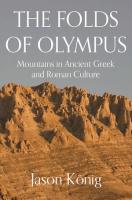
Princeton (2022) 444pp £35 (ISBN 9780691201290)
Ahead of my first Oxford tutorial (fifty years ago) I was given a Latin poem to analyse. It contained a couple of Horatian phrases but seemed puzzlingly absent from the classical canon. It turned out to be by Thomas Gray, and the clue (which I had failed to pick up) was that this fine piece of Neo-Latin expressed admiration for mountain scenery, a sentiment deemed foreign to the ancient world. My desperate suggestion that such feeling might be implicit in Euripidean maenads chanting ‘to the mountain!’ (Bacchae 977) did not go down well.
The view that mountains were feared or ignored before the age of the Picturesque and Sublime was classically expressed by Marjorie Hope Nicolson in Mountain Gloom and Mountain Glory (1959). It is essentially repeated in Robert MacFarlane’s widely read Mountains of the Mind (2003). Jason Kӧnig in this wonderfully rich and stimulating book (building in part on the work of Richard Buxton, especially his 1994 Imaginary Greece) offers a robust challenge on the aesthetics, and much else besides.
We start with ‘Mountains and the Divine’, based on the deep-seated analogy between physical and spiritual ascent. Evidence of Greek summit sanctuaries has steadily increased, and K. has climbed to most of them. Though pointing beyond, they were linked to communities below by processions and the visible smoke of sacrifice. Mountain herdsmen in Homeric similes seem proto-Romantic in the face of extreme weather events, but the gods look down in security from a remote Olympus. Ida is more accessible, and in the Homeric Hymn to Aphrodite sees a boundary breached by the goddess’s union with Anchises. Centuries later, Pausanias in his description of Roman Greece presents a sacred landscape imbued with mythical and historical associations. Mountain regions such as Arcadia are especially numinous. Mere mention of Cithaeron evokes its role in tragic drama. Parnassus itself seemed to resist the Gauls in 279 BC as it had resisted Xerxes in 480. Tourism and pilgrimage were never sharply distinguished, as we see again with Egeria in the Holy Land in the fourth century AD. Her quasi-divine summit views from Sinai or Nebo seem Homeric but recall Old Testament events. Already in the gospels (particularly Matthew) the frequent mountain scenes implicitly compare Jesus to Moses or Elijah.
The next section, ‘Mountain Visions’, deals with looking at mountains as well as looking from them. The great ‘beacon speech’ in Aeschylus’ Agamemnon, where Clytemnestra describes how she organised a chain of fire-signals from one mountain-top to another to bring news of the capture of Troy, is the imaginative amplification of a real-life practice. Distance and mist can lend enchantment. Mountains emphasise human vulnerability, none more so than volcanoes. Etna is described with awe by Pindar, Lucretius, Seneca, and in the pseudo-Virgilian poem devoted to it. In Longinus’ treatise On the Sublime it provides a rare example of this quality in landscape rather than literature. According to tradition, the pre-Socratic philosopher Empedocles threw himself into its fiery crater (Matthew Arnold’s poem might have been mentioned), but K. in a later chapter quotes Strabo’s rationalist dismissal (impossible to get near enough). Mountains are depicted in stylised but significant ways on Greek vases and Roman wall paintings. In poetic texts their symbolism can be good or bad: Virgil’s Aeneid offers both the mountain lair of the monster Cacus and the epic’s hero as the dignified Father Appeninus. A single reference can confer immortality: Soracte in Horace Odes 1.9 is the supreme example.
We then move to ‘Mountain Conquest’. Although hoplite battles presuppose low and level ground, military campaigning in mountain landscapes is a recurrent theme in ancient literature. Local instances can be important (the Messenians occupied Mount Ithome against Sparta in the seventh century BC and again in the fifth), but the first major example is the campaign of Xerxes. Landscape alteration and the transgression of natural boundaries are in Herodotus always ill-omened. After cutting a canal through Mount Athos, the Persian king is (thanks to a disloyal and knowledgeable Greek) successful at Thermopylae, but things go downhill from there. The next famous episode is Alexander capturing the Sogdian Rock. He has a serious military objective (and climbing was not an ancient sport), but Arrian’s account gives a strong sense of competitiveness and challenge. Perhaps best known of all is Hannibal crossing the Alps, here considered in the version of Polybius (who claimed to have retraced the route) rather than Livy’s more familiar one. Here we have both the ‘haptic’ reality of harsh mountain conditions and the great moment where the view down into Italy is laid open.
The Herodotean (originally Homeric) point about tough lands breeding tough men, and the broader environmental determinism of the Hippocratic Airs, Waters, Places, usher in the final section ‘Living in Mountains’. The economy of mountain communities depended variously on hunting, forestry, charcoal burning and mining. Transhumance (moving livestock to upland summer pastures) is crucial to the plot of Sophocles’ Oedipus Tyrannus, and has a parallel in the life of the Sarakatsani studied by the anthropologist John Campbell in the 1950s. Mountain people can be portrayed as uncivilised and threatening outsiders, but for the shipwrecked Second Sophistic author Dio Chrysostom in his Euboean Oration they are (at least initially) models of rustic hospitality. For the holy men of Late Antiquity, mountains were an alternative to the Egyptian desert as places of contemplative retreat. Roman monuments (the Res Gestae of Augustus, the scenes on Trajan’s Column) stress human control of mountains, but a strong tradition in ancient literature presents them as enticingly beyond it.
Many of the photos are K.’s own, a slightly blurry and amateur quality only adding to their charm. Copy editing and proof reading have been done to a very high standard.
John Taylor
